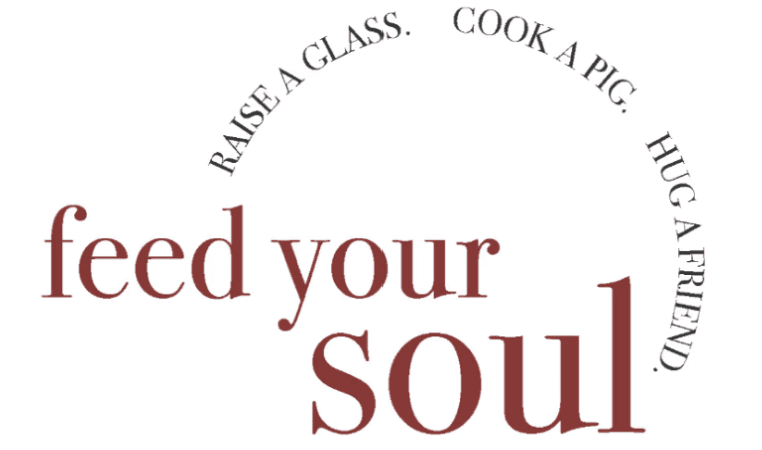
Feed Your Soul

Design Digest
Design Digest
Anthony Bourdain was more than a chef. He was a storyteller, a world traveler, and a reluctant icon whose presence shaped how we think about food, culture, and authenticity. After his tragic passing, many tributes circled a common theme: Bourdain fed more than appetites—he fed souls. This exhibition seeks to invite guests into his world: gritty yet graceful, raw yet thoughtful. Through carefully designed visuals and environments, Feed Your Soul reintroduces Bourdain as he was—beautifully human.
Introducing Feed Your Soul
Savor the Journey
Feed Your Soul is an immersive museum exhibition concept that honors the life, voice, and impact of Anthony Bourdain. Developed as part of a graphic design studio course, the project included exhibition branding, advertisements, environmental graphics, a take-home pamphlet, and retail packaging for the gift shop. More than a celebration of his culinary legacy, this project explores Bourdain’s raw humanity and reminds visitors to savor life—and each other—deeply.
Savor the Journey
Feed Your Soul is an immersive museum exhibition concept that honors the life, voice, and impact of Anthony Bourdain. Developed as part of a graphic design studio course, the project included exhibition branding, advertisements, environmental graphics, a take-home pamphlet, and retail packaging for the gift shop. More than a celebration of his culinary legacy, this project explores Bourdain’s raw humanity and reminds visitors to savor life—and each other—deeply.
Savor the Journey
Feed Your Soul is an immersive museum exhibition concept that honors the life, voice, and impact of Anthony Bourdain. Developed as part of a graphic design studio course, the project included exhibition branding, advertisements, environmental graphics, a take-home pamphlet, and retail packaging for the gift shop. More than a celebration of his culinary legacy, this project explores Bourdain’s raw humanity and reminds visitors to savor life—and each other—deeply.


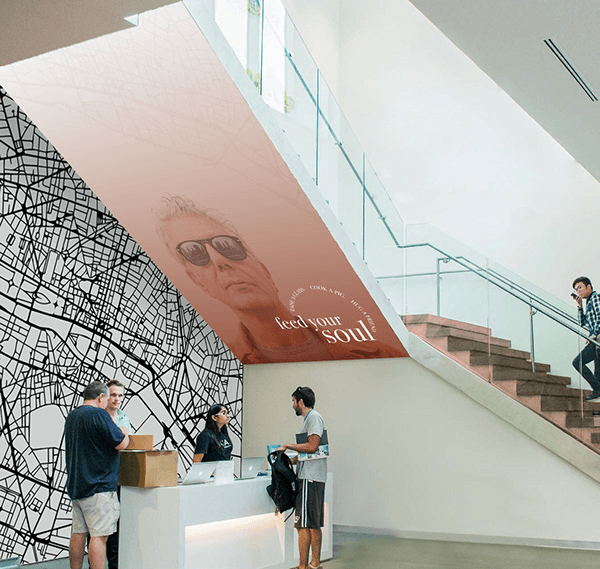

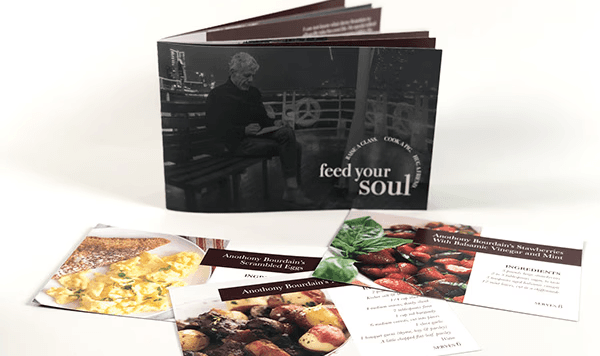

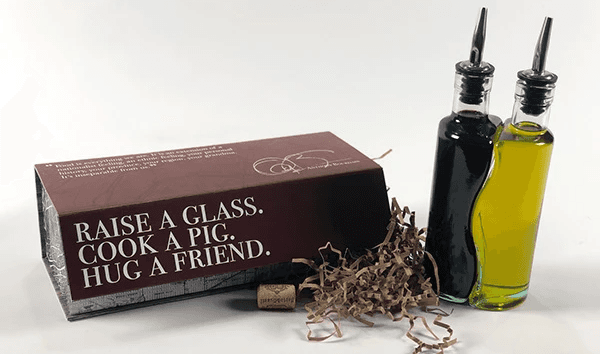

Discover
Discover
The multiethnic chef Anthony Michael Bourdain was the agreeably foul-mouthed, bad boy of gastronomy—gritty, dark, and magnetic. Unapologetically himself, he stood as an uncompromising figure of moral clarity and impeccable taste. Despite his global stature, he carried a rare warmth and familiarity that made us feel like he was our best buddy, our closest confidant.
Behind his signature smirk and off-the-cuff swagger, Bourdain’s writing revealed a more complex interior life. His fictional works, in particular, exposed the shadows he lived with. He was deeply self-critical—a melancholic soul at odds with the charismatic TV host we welcomed into our homes. As journalist Bustillos observed, Bourdain’s inner turmoil was no secret. And in his own words, “by letting the world in on his love affair with cooking, he managed to kill the thing he loved the most” (Hughes).
When he died on June 8, 2018, a central truth rose from the outpouring of grief and tributes: Bourdain was the embodiment of authenticity. Drew Magary, writing for GQ, cautioned against fixating on the demons that ultimately claimed him. Instead, he urged us to remember the way Bourdain lived—with humility, curiosity, and a relentless pursuit of the real. “Fame and avarice,” Magary writes, “took a back seat to the feeding of your very soul.”
So let’s honor the life Bourdain tried to live.
Raise a glass. Cook a pig. Hug a friend.
Better make mine a double.
Research Recap
Research began by immersing myself in Bourdain’s books, shows, interviews, and the many tributes written in his wake. I studied museum exhibit design, from layout to interactive storytelling, to understand how to create an emotionally resonant yet informative experience. The discovery process revealed Bourdain’s lasting impact: his honesty, his advocacy for underrepresented voices, and his call to embrace the unknown—not just across borders, but within ourselves.
Research Recap
Research began by immersing myself in Bourdain’s books, shows, interviews, and the many tributes written in his wake. I studied museum exhibit design, from layout to interactive storytelling, to understand how to create an emotionally resonant yet informative experience. The discovery process revealed Bourdain’s lasting impact: his honesty, his advocacy for underrepresented voices, and his call to embrace the unknown—not just across borders, but within ourselves.
Research Recap
Research began by immersing myself in Bourdain’s books, shows, interviews, and the many tributes written in his wake. I studied museum exhibit design, from layout to interactive storytelling, to understand how to create an emotionally resonant yet informative experience. The discovery process revealed Bourdain’s lasting impact: his honesty, his advocacy for underrepresented voices, and his call to embrace the unknown—not just across borders, but within ourselves.
" If I'm an advocate for anything, it's to move. As far as you can, as much as you can. Across the ocean, or simply across the river. Walk in someone else's shoes or least eat their food. Open your mind, get up off the couch. Move."
Anthony Bourdain
Define
Define
The goal was to create a space that could balance reverence with realness. This project would not sanitize or overly glamorize Bourdain’s legacy, but rather reflect it in full color—humor, grit, vulnerability, and all.
The experience needed to communicate three key themes:
The authenticity of Bourdain’s life and voice
The globalism of his perspective and the cultures he elevated
The emotional honesty that underpinned his writing and storytelling
These insights shaped the emotional tone, narrative structure, and visual language of the exhibition.
"Raise a glass. Cook a pig. Hug a friend."
Magary for GQ
Attribute Word Cloud
To define the emotional and visual tone of the exhibition, I created an attribute word cloud that explored the dualities of Anthony Bourdain’s persona—rugged yet refined, cynical yet compassionate, bold yet introspective. This mapping exercise helped identify the key characteristics that would guide the design language, ensuring that every element from typography to color palette stayed true to Bourdain’s complex identity.
Attribute Word Cloud
To define the emotional and visual tone of the exhibition, I created an attribute word cloud that explored the dualities of Anthony Bourdain’s persona—rugged yet refined, cynical yet compassionate, bold yet introspective. This mapping exercise helped identify the key characteristics that would guide the design language, ensuring that every element from typography to color palette stayed true to Bourdain’s complex identity.
Attribute Word Cloud
To define the emotional and visual tone of the exhibition, I created an attribute word cloud that explored the dualities of Anthony Bourdain’s persona—rugged yet refined, cynical yet compassionate, bold yet introspective. This mapping exercise helped identify the key characteristics that would guide the design language, ensuring that every element from typography to color palette stayed true to Bourdain’s complex identity.
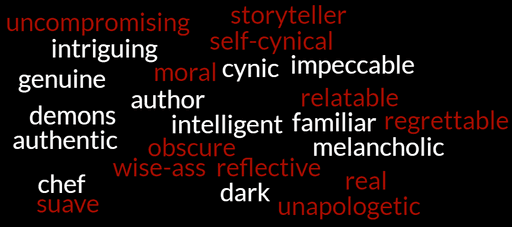

Mind Map
The mind map was used as an exploratory tool to organize early research, thematic concepts, and design directions. Centered around Anthony Bourdain’s legacy, the map branches out into personal influences, cultural touchpoints, emotional triggers, and potential sensory experiences. This helped clarify the exhibition’s narrative arc and identify opportunities to weave in visual metaphors, audience engagement, and storytelling moments.
Mind Map
The mind map was used as an exploratory tool to organize early research, thematic concepts, and design directions. Centered around Anthony Bourdain’s legacy, the map branches out into personal influences, cultural touchpoints, emotional triggers, and potential sensory experiences. This helped clarify the exhibition’s narrative arc and identify opportunities to weave in visual metaphors, audience engagement, and storytelling moments.
Mind Map
The mind map was used as an exploratory tool to organize early research, thematic concepts, and design directions. Centered around Anthony Bourdain’s legacy, the map branches out into personal influences, cultural touchpoints, emotional triggers, and potential sensory experiences. This helped clarify the exhibition’s narrative arc and identify opportunities to weave in visual metaphors, audience engagement, and storytelling moments.
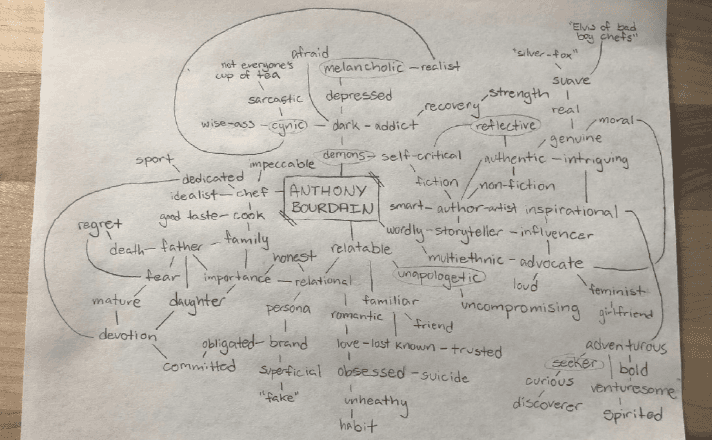

Mood Board
The mood board establishes the aesthetic foundation for the Feed Your Soul exhibition. These references reflect Bourdain’s globe-trotting spirit and unpolished charm while honoring the raw beauty of his storytelling. The board guided the look and feel of the final deliverables, evoking both wanderlust and emotional intimacy.
Mood Board
The mood board establishes the aesthetic foundation for the Feed Your Soul exhibition. These references reflect Bourdain’s globe-trotting spirit and unpolished charm while honoring the raw beauty of his storytelling. The board guided the look and feel of the final deliverables, evoking both wanderlust and emotional intimacy.
Mood Board
The mood board establishes the aesthetic foundation for the Feed Your Soul exhibition. These references reflect Bourdain’s globe-trotting spirit and unpolished charm while honoring the raw beauty of his storytelling. The board guided the look and feel of the final deliverables, evoking both wanderlust and emotional intimacy.
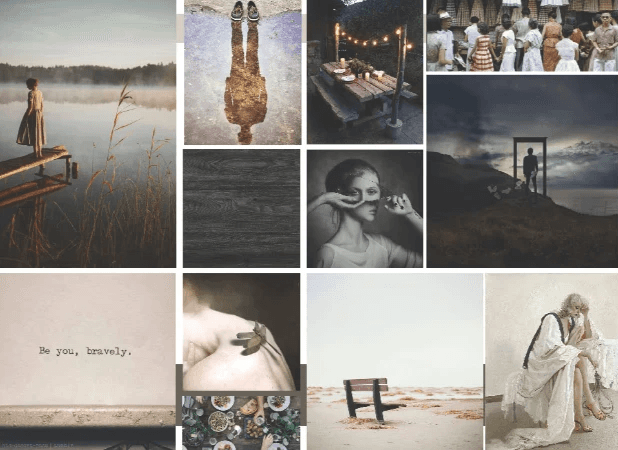

"Travel changes you. As you move through this life and this world you change things slightly, you leave marks behind, however small. And in return, life - and travel - leaves marks on you. Most of the time those marks - on your body of on your heart - are beautiful. Often, though, they hurt."
Anthony Bourdain
Design
Design
The exhibit identity centers around rugged yet classic typography, inspired by Bourdain’s no-frills, old-school persona. I selected Bodoni as the primary typeface to reflect his timeless, rough-around-the-edges charm. The color palette features bold, earthy tones—deep reds, smoky charcoals, and turmeric golds—to evoke both grit and warmth.
Identity Development
The visual identity for Feed Your Soul was designed to capture the raw, unfiltered essence of Anthony Bourdain—gritty, soulful, and unapologetically human. Drawing from his old-school charm and world-worn wisdom, I developed a cohesive system that blends vintage textures, bold typography, and global iconography. Every visual decision—from the type choice to the color palette—was made to reflect the tension between wanderlust and weariness that defined Bourdain’s life. The resulting identity balances the emotional weight of the exhibition with an inviting sense of warmth, curiosity, and lived experience.
Identity Development
The visual identity for Feed Your Soul was designed to capture the raw, unfiltered essence of Anthony Bourdain—gritty, soulful, and unapologetically human. Drawing from his old-school charm and world-worn wisdom, I developed a cohesive system that blends vintage textures, bold typography, and global iconography. Every visual decision—from the type choice to the color palette—was made to reflect the tension between wanderlust and weariness that defined Bourdain’s life. The resulting identity balances the emotional weight of the exhibition with an inviting sense of warmth, curiosity, and lived experience.
Identity Development
The visual identity for Feed Your Soul was designed to capture the raw, unfiltered essence of Anthony Bourdain—gritty, soulful, and unapologetically human. Drawing from his old-school charm and world-worn wisdom, I developed a cohesive system that blends vintage textures, bold typography, and global iconography. Every visual decision—from the type choice to the color palette—was made to reflect the tension between wanderlust and weariness that defined Bourdain’s life. The resulting identity balances the emotional weight of the exhibition with an inviting sense of warmth, curiosity, and lived experience.
Typography Selection
Anthony Bourdain was old school, rugged, and classic—a man who felt equally at home in a street-side noodle stall or a Michelin-starred kitchen. I chose Bodoni Book, Oldstyle, and Old Face as the primary typeface for this project because it reflects that same spirit: timeless yet bold, refined yet unpretentious. Bodoni's sharp serifs and strong contrast give it a vintage, editorial feel that mirrors Bourdain’s roots as a writer and storyteller. At the same time, it carries a certain grit and edge—like the man himself—capturing the tension between elegance and raw honesty that defined his voice. It's a typeface that commands attention without trying too hard, perfect for a tribute that honors both his intellect and his intensity.
Typography Selection
Anthony Bourdain was old school, rugged, and classic—a man who felt equally at home in a street-side noodle stall or a Michelin-starred kitchen. I chose Bodoni Book, Oldstyle, and Old Face as the primary typeface for this project because it reflects that same spirit: timeless yet bold, refined yet unpretentious. Bodoni's sharp serifs and strong contrast give it a vintage, editorial feel that mirrors Bourdain’s roots as a writer and storyteller. At the same time, it carries a certain grit and edge—like the man himself—capturing the tension between elegance and raw honesty that defined his voice. It's a typeface that commands attention without trying too hard, perfect for a tribute that honors both his intellect and his intensity.
Typography Selection
Anthony Bourdain was old school, rugged, and classic—a man who felt equally at home in a street-side noodle stall or a Michelin-starred kitchen. I chose Bodoni Book, Oldstyle, and Old Face as the primary typeface for this project because it reflects that same spirit: timeless yet bold, refined yet unpretentious. Bodoni's sharp serifs and strong contrast give it a vintage, editorial feel that mirrors Bourdain’s roots as a writer and storyteller. At the same time, it carries a certain grit and edge—like the man himself—capturing the tension between elegance and raw honesty that defined his voice. It's a typeface that commands attention without trying too hard, perfect for a tribute that honors both his intellect and his intensity.
Bodoni 72 Book
ABCDEFGHIJKLMNOPQRSTUVWXYZ
abcdefghijklmnopqrstuvwxyz
1234567890
Bodoni 72 Oldstyle
ABDEFGHIJKLMNOPQRSTUVWXYZ
abcdefghijklmnopqrstuvwxyz
1234567890
Baskerville Old Face
ABCDEFGHIJKLMNOPQRSTUVWXYZ
abcdefghijklmnopqrstuvwxyz
1234567890
Color Palette
Anthony Bourdain was a seeker. He was a man driven by a hunger to share the world. He encouraged us to feed our very souls and to take beyond our fill. The rich color palette I have selected support this concept. The view is allowed to indulge in the deep ruby gem tones while the murkier, more neutral colors pull the viewer back to a muted, subtle moment of reflection.
Color Palette
Anthony Bourdain was a seeker. He was a man driven by a hunger to share the world. He encouraged us to feed our very souls and to take beyond our fill. The rich color palette I have selected support this concept. The view is allowed to indulge in the deep ruby gem tones while the murkier, more neutral colors pull the viewer back to a muted, subtle moment of reflection.
Color Palette
Anthony Bourdain was a seeker. He was a man driven by a hunger to share the world. He encouraged us to feed our very souls and to take beyond our fill. The rich color palette I have selected support this concept. The view is allowed to indulge in the deep ruby gem tones while the murkier, more neutral colors pull the viewer back to a muted, subtle moment of reflection.

Graphic Elements
These graphic elements are made up of Bourdain himself, his signature, and maps of both New York where he lived and worked, and Paris where he fell in love with food and ultimately ended his life.
Graphic Elements
These graphic elements are made up of Bourdain himself, his signature, and maps of both New York where he lived and worked, and Paris where he fell in love with food and ultimately ended his life.
Graphic Elements
These graphic elements are made up of Bourdain himself, his signature, and maps of both New York where he lived and worked, and Paris where he fell in love with food and ultimately ended his life.
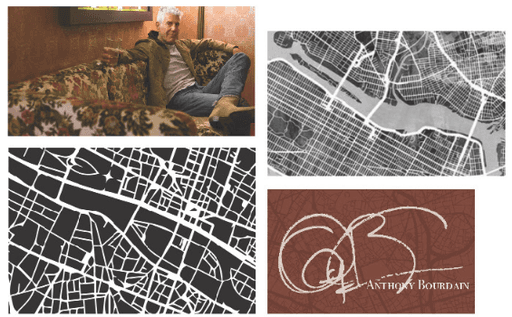

Logo Development
The logotype, set in Bodoni, is inspired by Anthony Bourdain's classic style, with an emphasis on his belief that "what goes around, comes around." The design showcases the holistic authenticity that he had in his shows, writings, and dialogues. An embodiment of authenticity, he was unafraid to tell the whole truth of his story and opinion. The open circle element was inspired by how he not only inspired people to body explore new cultures with an open mind but to share about the experiences that they had. The emphasis on the word "soul" was to remind the viewers of our mortality. There is a time limit on our abilities to explore and seek new adventures. "Soul" reminds the view that while Anthony Bourdain died, the soul of his life's work may continue to influence our lives. The subtitle "Raise a Glass. Cook a Pig. Hug a Friend." is quote from the writer of a GQ article titled "Anthony Bourdain Was the Most Interesting Man in the World." He, like myself, believe that Bourdain lived an incredible life that we should all (to some degree) attempt to follow. I also believe he left us a sort of handbook guide to living well and these three commandments just may be the perfect place to start.
Logo Development
The logotype, set in Bodoni, is inspired by Anthony Bourdain's classic style, with an emphasis on his belief that "what goes around, comes around." The design showcases the holistic authenticity that he had in his shows, writings, and dialogues. An embodiment of authenticity, he was unafraid to tell the whole truth of his story and opinion. The open circle element was inspired by how he not only inspired people to body explore new cultures with an open mind but to share about the experiences that they had. The emphasis on the word "soul" was to remind the viewers of our mortality. There is a time limit on our abilities to explore and seek new adventures. "Soul" reminds the view that while Anthony Bourdain died, the soul of his life's work may continue to influence our lives. The subtitle "Raise a Glass. Cook a Pig. Hug a Friend." is quote from the writer of a GQ article titled "Anthony Bourdain Was the Most Interesting Man in the World." He, like myself, believe that Bourdain lived an incredible life that we should all (to some degree) attempt to follow. I also believe he left us a sort of handbook guide to living well and these three commandments just may be the perfect place to start.
Logo Development
The logotype, set in Bodoni, is inspired by Anthony Bourdain's classic style, with an emphasis on his belief that "what goes around, comes around." The design showcases the holistic authenticity that he had in his shows, writings, and dialogues. An embodiment of authenticity, he was unafraid to tell the whole truth of his story and opinion. The open circle element was inspired by how he not only inspired people to body explore new cultures with an open mind but to share about the experiences that they had. The emphasis on the word "soul" was to remind the viewers of our mortality. There is a time limit on our abilities to explore and seek new adventures. "Soul" reminds the view that while Anthony Bourdain died, the soul of his life's work may continue to influence our lives. The subtitle "Raise a Glass. Cook a Pig. Hug a Friend." is quote from the writer of a GQ article titled "Anthony Bourdain Was the Most Interesting Man in the World." He, like myself, believe that Bourdain lived an incredible life that we should all (to some degree) attempt to follow. I also believe he left us a sort of handbook guide to living well and these three commandments just may be the perfect place to start.
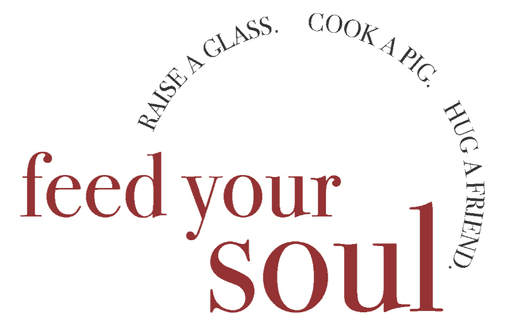

"Food is everything we are. It is an extension of a nationalist feeling, an ethnic feeling, your personal history, your province, your religion, your grandma. It's inseparable from us."
Anthony Bourdain
Deliver
Deliver
The final design system created a seamless brand experience across print, physical space, and merchandise. The exhibit layout featured curated zones—each representing a stage in Bourdain’s life, from kitchen line cook to cultural ambassador. Souvenir packaging for the gift shop included specialty wrapping for an oil and vinegar set.
Museum Exteriror
The exterior graphic poster was designed to be impactful, as Bourdain's life was to so many lives. For those unable to travel themselves, he was a vessel to live vicariously through. He was also bold like the color used; the deep red indulgent, the black and white in stark contrast. He was a deeply complex figure and I wanted to convey just a small preview of the man people knew. The viewer sees him sitting, in somber contemplation with a map texture behind him reminding them of the travel he loved. The words "feed your soul" in contrast against his dark shirt and grayscale figure places an emphasis on the positive, savoring lessons he taught us while himself absorbed by darkness.
Museum Exteriror
The exterior graphic poster was designed to be impactful, as Bourdain's life was to so many lives. For those unable to travel themselves, he was a vessel to live vicariously through. He was also bold like the color used; the deep red indulgent, the black and white in stark contrast. He was a deeply complex figure and I wanted to convey just a small preview of the man people knew. The viewer sees him sitting, in somber contemplation with a map texture behind him reminding them of the travel he loved. The words "feed your soul" in contrast against his dark shirt and grayscale figure places an emphasis on the positive, savoring lessons he taught us while himself absorbed by darkness.
Museum Exteriror
The exterior graphic poster was designed to be impactful, as Bourdain's life was to so many lives. For those unable to travel themselves, he was a vessel to live vicariously through. He was also bold like the color used; the deep red indulgent, the black and white in stark contrast. He was a deeply complex figure and I wanted to convey just a small preview of the man people knew. The viewer sees him sitting, in somber contemplation with a map texture behind him reminding them of the travel he loved. The words "feed your soul" in contrast against his dark shirt and grayscale figure places an emphasis on the positive, savoring lessons he taught us while himself absorbed by darkness.
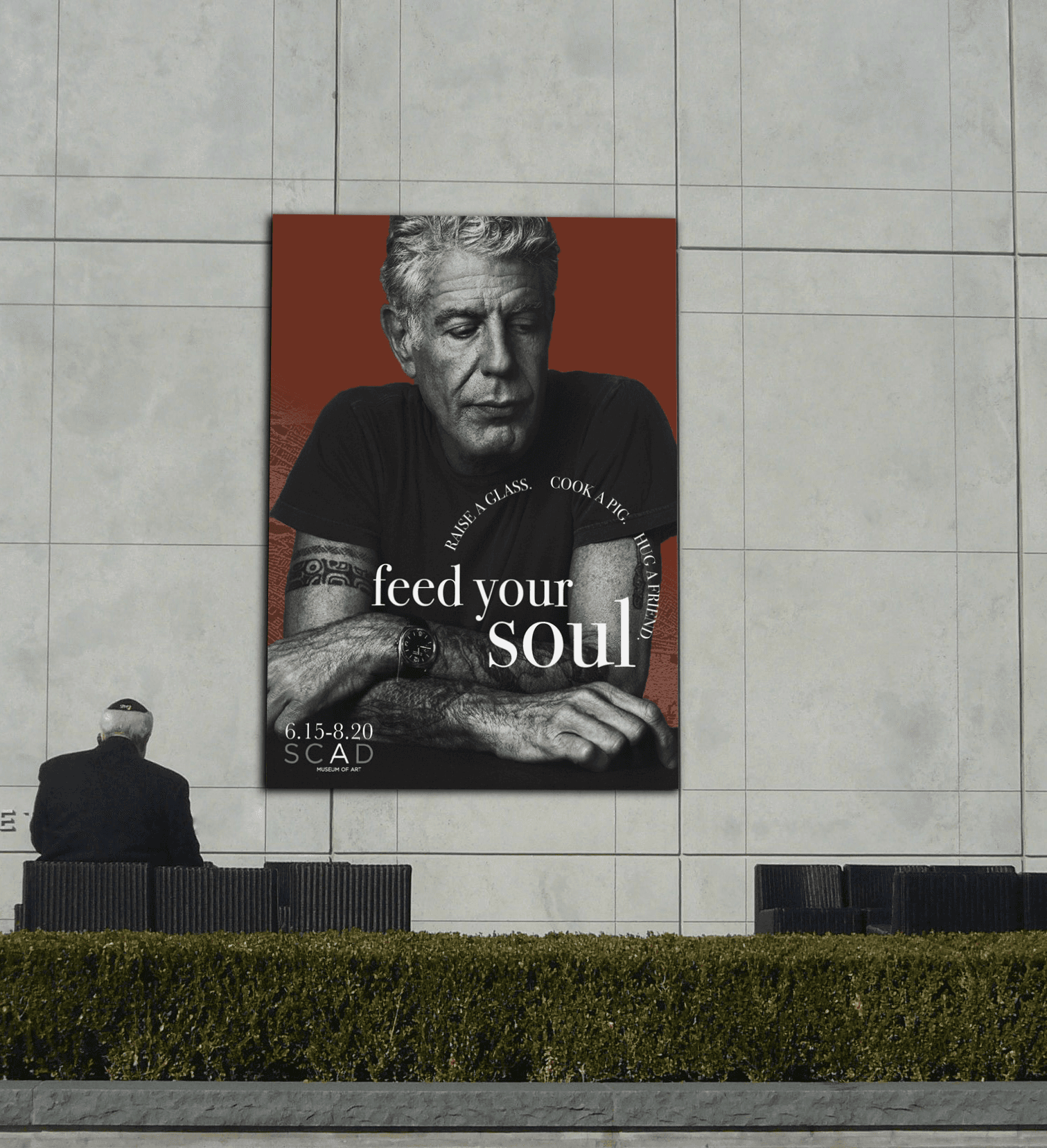

Exterior graphic
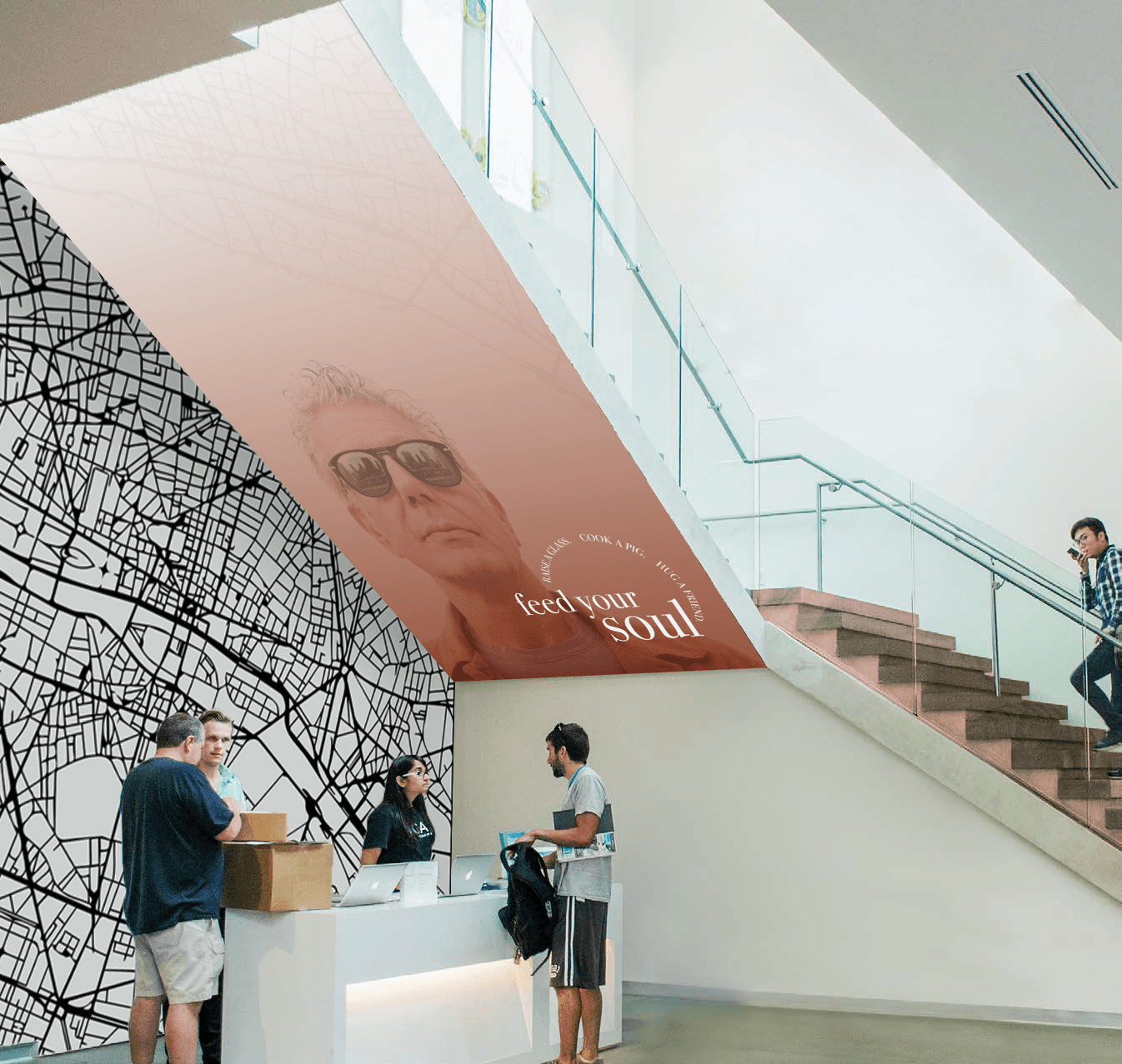

Introduction wall
Exhibition Interior
This exhibition is a celebratory tribute to Anthony Bourdain and the life he lived. I choose this image of him because he is relaxed, smiling, has a drink in his hand and room next to him on the couch for company. He invites the viewer in with his warmth and the promise of good conversation. He invites the viewer to sit, stay awhile, and exchange stories and wisdom. While I did not want the experience to be sad, I also did not want to ignore the somberness of the situation. Keeping this in mind, I enthroned him darkness. Not the kind of darkness that causes anxiety, but enough to remind the viewer that part of his authentic lifestyle was that he was willing to talk about the dark parts of his life publicly. Finally, I choose to incorporate map textures that have been distorted, re-colored, pixelated, and morphed into the scene. The first map (in red) is the map of Paris, the birthplace of Bourdain's love affair with food. His first trip to Paris was on a family vacation. While at a restaurant, he ordered escargot because he knew he wanted to try something he could not get as good anywhere else. From that moment, he was hooked on good food and the cultures that surrounded. Later in life, he became a chef in New York City, the second map incorporated (behind the text). It was in New York that he wrote his book "Kitchen Confidential" which catapulted him to fame. However, he once lamented that "by letting the world in on his love affair with cooking, he managed to kill the thing he loved most." The map of Paris is on the end intentionally. It sits where the museum visitor would both enter and exit the exhibition. Paris was the beginning of his journey and was also the end. In June of 2018, when he missed a reservation for a meal at one of his favorite restaurants in Paris, it was clear something was very wrong. The next morning he was found dead by suicide. His tumultuous affair with life itself was finally over.
Exhibition Interior
This exhibition is a celebratory tribute to Anthony Bourdain and the life he lived. I choose this image of him because he is relaxed, smiling, has a drink in his hand and room next to him on the couch for company. He invites the viewer in with his warmth and the promise of good conversation. He invites the viewer to sit, stay awhile, and exchange stories and wisdom. While I did not want the experience to be sad, I also did not want to ignore the somberness of the situation. Keeping this in mind, I enthroned him darkness. Not the kind of darkness that causes anxiety, but enough to remind the viewer that part of his authentic lifestyle was that he was willing to talk about the dark parts of his life publicly. Finally, I choose to incorporate map textures that have been distorted, re-colored, pixelated, and morphed into the scene. The first map (in red) is the map of Paris, the birthplace of Bourdain's love affair with food. His first trip to Paris was on a family vacation. While at a restaurant, he ordered escargot because he knew he wanted to try something he could not get as good anywhere else. From that moment, he was hooked on good food and the cultures that surrounded. Later in life, he became a chef in New York City, the second map incorporated (behind the text). It was in New York that he wrote his book "Kitchen Confidential" which catapulted him to fame. However, he once lamented that "by letting the world in on his love affair with cooking, he managed to kill the thing he loved most." The map of Paris is on the end intentionally. It sits where the museum visitor would both enter and exit the exhibition. Paris was the beginning of his journey and was also the end. In June of 2018, when he missed a reservation for a meal at one of his favorite restaurants in Paris, it was clear something was very wrong. The next morning he was found dead by suicide. His tumultuous affair with life itself was finally over.
Exhibition Interior
This exhibition is a celebratory tribute to Anthony Bourdain and the life he lived. I choose this image of him because he is relaxed, smiling, has a drink in his hand and room next to him on the couch for company. He invites the viewer in with his warmth and the promise of good conversation. He invites the viewer to sit, stay awhile, and exchange stories and wisdom. While I did not want the experience to be sad, I also did not want to ignore the somberness of the situation. Keeping this in mind, I enthroned him darkness. Not the kind of darkness that causes anxiety, but enough to remind the viewer that part of his authentic lifestyle was that he was willing to talk about the dark parts of his life publicly. Finally, I choose to incorporate map textures that have been distorted, re-colored, pixelated, and morphed into the scene. The first map (in red) is the map of Paris, the birthplace of Bourdain's love affair with food. His first trip to Paris was on a family vacation. While at a restaurant, he ordered escargot because he knew he wanted to try something he could not get as good anywhere else. From that moment, he was hooked on good food and the cultures that surrounded. Later in life, he became a chef in New York City, the second map incorporated (behind the text). It was in New York that he wrote his book "Kitchen Confidential" which catapulted him to fame. However, he once lamented that "by letting the world in on his love affair with cooking, he managed to kill the thing he loved most." The map of Paris is on the end intentionally. It sits where the museum visitor would both enter and exit the exhibition. Paris was the beginning of his journey and was also the end. In June of 2018, when he missed a reservation for a meal at one of his favorite restaurants in Paris, it was clear something was very wrong. The next morning he was found dead by suicide. His tumultuous affair with life itself was finally over.


Interior graphic
Exhibition Pamphlet
It's claimed that Bourdain was the most interesting man in the world. This design narrative for the exhibition pamphlet was designed to showcase this idea. He was more than a celebrity we knew from TV. He was a writer, a thinker, a traveler, an interviewer, a chef, a father, a son. He hung out with people we will never know. He ate food we will never eat. He went places we will never know. But he shared it all with us. The pamphlet opens and starts with the celebrity version of Anthony Bourdain in a tux proposing a toast with his life's motto above. Over the course of the booklet, we see him with a bit more intimacy. The first spread is again a photo of Bourdain as the celebrity posting for his show's promotional material. The next spread gets a bit more personal; we see him sharing a meal with Obama. This is still very much for the camera during filming for his show but he references this moment often later in various contexts of his life saying that it was a "good meal with a good friend." The next spread is even more personal as we see him enjoying a meal on a boat with a fisherman while he is abroad someplace. Although his moment was still for his show, I believe it represents the moments he spent travelling purely for pleasure. The next spread represents his demons; we see him sitting looking down, shoulder hunched over. He is in a silent contemplate. We will never know what truly led him to take his own life but he still implores us to "raise a glass, cook a pig" and "hug a friend." We see this in the next page; him, with friends, beneath some palm trees near the water, a smile of joy upon his face. Finally, the Anthony Bourdain his friends knew is known to us as well.
Exhibition Pamphlet
It's claimed that Bourdain was the most interesting man in the world. This design narrative for the exhibition pamphlet was designed to showcase this idea. He was more than a celebrity we knew from TV. He was a writer, a thinker, a traveler, an interviewer, a chef, a father, a son. He hung out with people we will never know. He ate food we will never eat. He went places we will never know. But he shared it all with us. The pamphlet opens and starts with the celebrity version of Anthony Bourdain in a tux proposing a toast with his life's motto above. Over the course of the booklet, we see him with a bit more intimacy. The first spread is again a photo of Bourdain as the celebrity posting for his show's promotional material. The next spread gets a bit more personal; we see him sharing a meal with Obama. This is still very much for the camera during filming for his show but he references this moment often later in various contexts of his life saying that it was a "good meal with a good friend." The next spread is even more personal as we see him enjoying a meal on a boat with a fisherman while he is abroad someplace. Although his moment was still for his show, I believe it represents the moments he spent travelling purely for pleasure. The next spread represents his demons; we see him sitting looking down, shoulder hunched over. He is in a silent contemplate. We will never know what truly led him to take his own life but he still implores us to "raise a glass, cook a pig" and "hug a friend." We see this in the next page; him, with friends, beneath some palm trees near the water, a smile of joy upon his face. Finally, the Anthony Bourdain his friends knew is known to us as well.
Exhibition Pamphlet
It's claimed that Bourdain was the most interesting man in the world. This design narrative for the exhibition pamphlet was designed to showcase this idea. He was more than a celebrity we knew from TV. He was a writer, a thinker, a traveler, an interviewer, a chef, a father, a son. He hung out with people we will never know. He ate food we will never eat. He went places we will never know. But he shared it all with us. The pamphlet opens and starts with the celebrity version of Anthony Bourdain in a tux proposing a toast with his life's motto above. Over the course of the booklet, we see him with a bit more intimacy. The first spread is again a photo of Bourdain as the celebrity posting for his show's promotional material. The next spread gets a bit more personal; we see him sharing a meal with Obama. This is still very much for the camera during filming for his show but he references this moment often later in various contexts of his life saying that it was a "good meal with a good friend." The next spread is even more personal as we see him enjoying a meal on a boat with a fisherman while he is abroad someplace. Although his moment was still for his show, I believe it represents the moments he spent travelling purely for pleasure. The next spread represents his demons; we see him sitting looking down, shoulder hunched over. He is in a silent contemplate. We will never know what truly led him to take his own life but he still implores us to "raise a glass, cook a pig" and "hug a friend." We see this in the next page; him, with friends, beneath some palm trees near the water, a smile of joy upon his face. Finally, the Anthony Bourdain his friends knew is known to us as well.
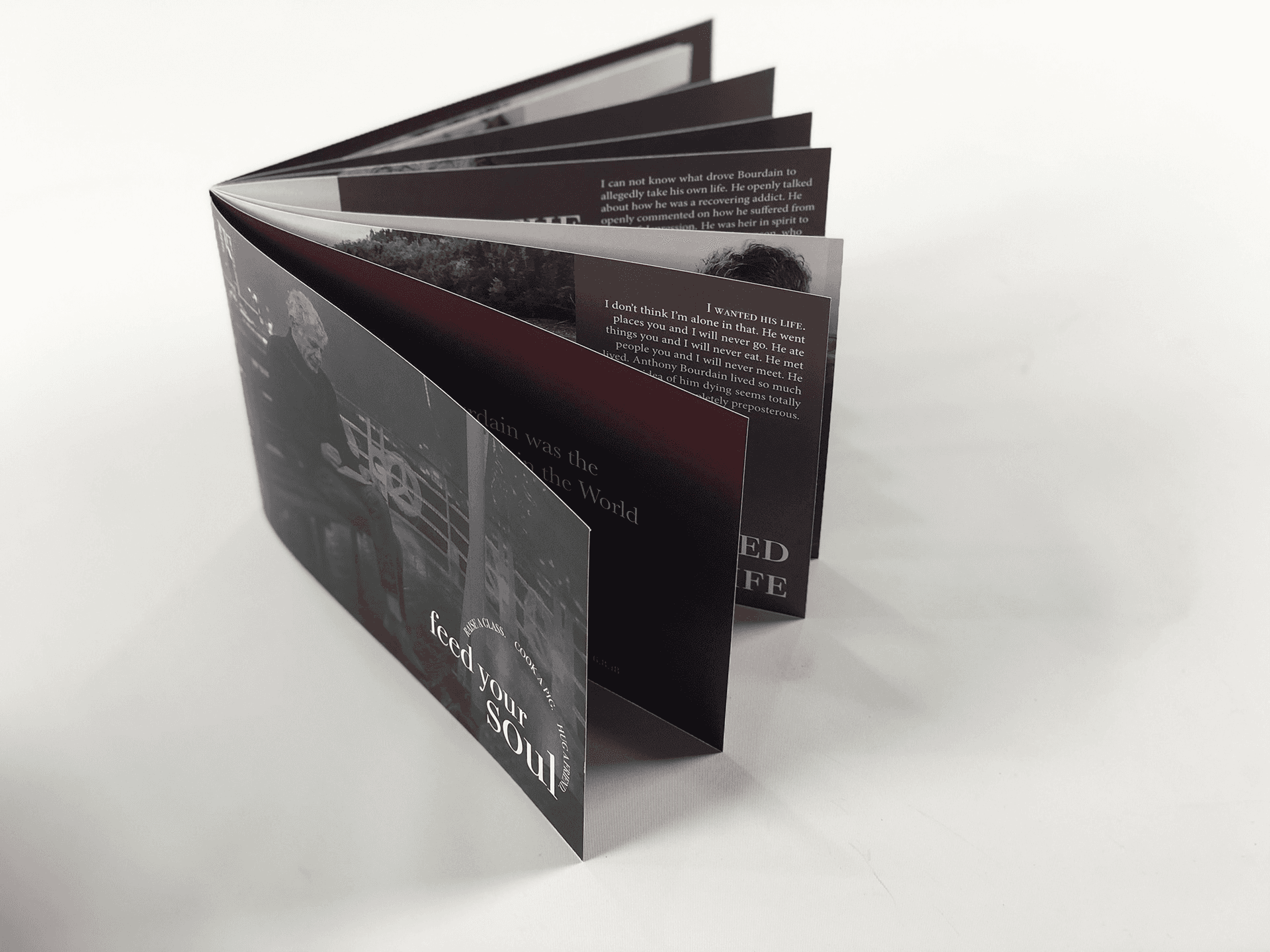
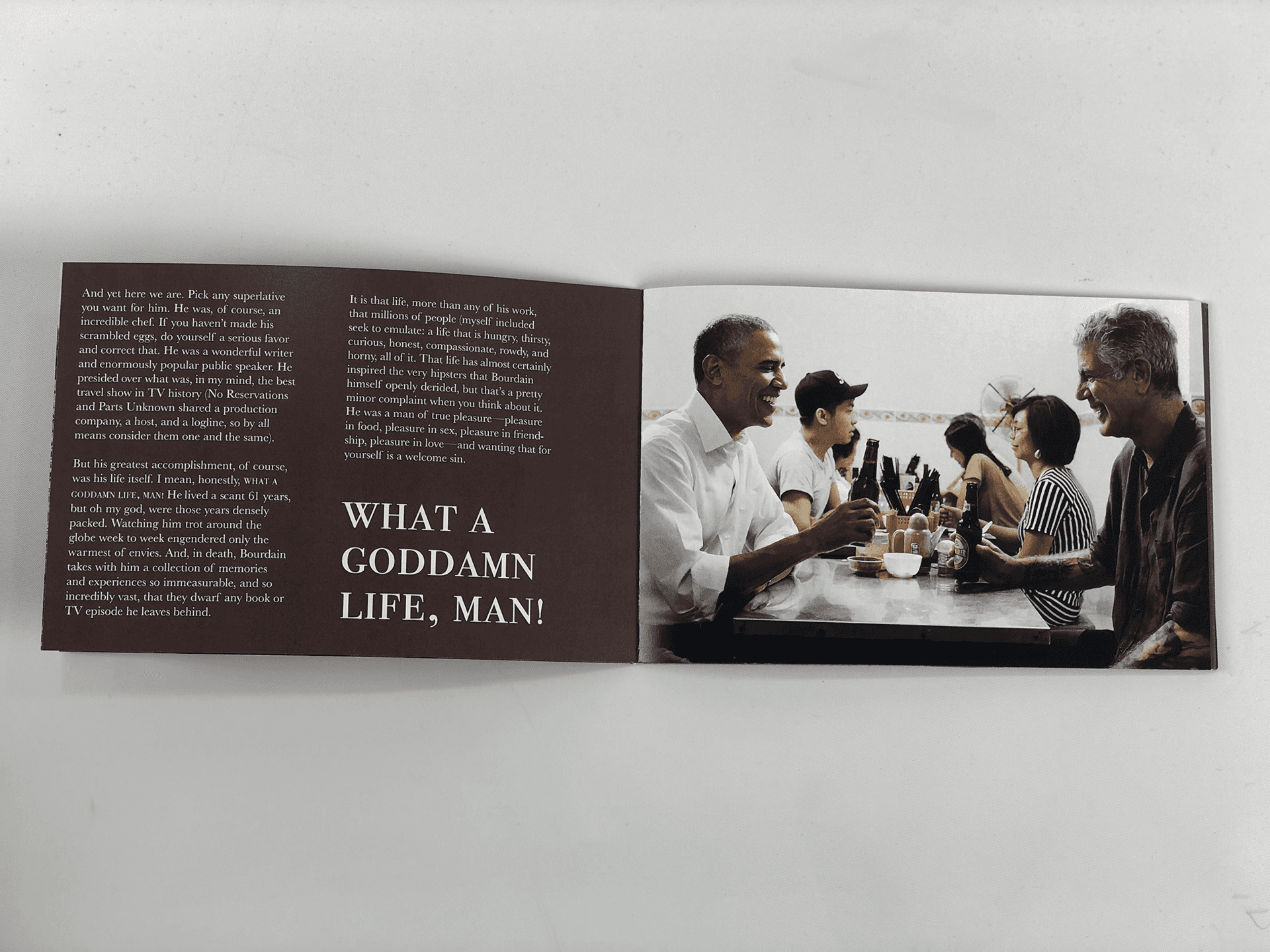



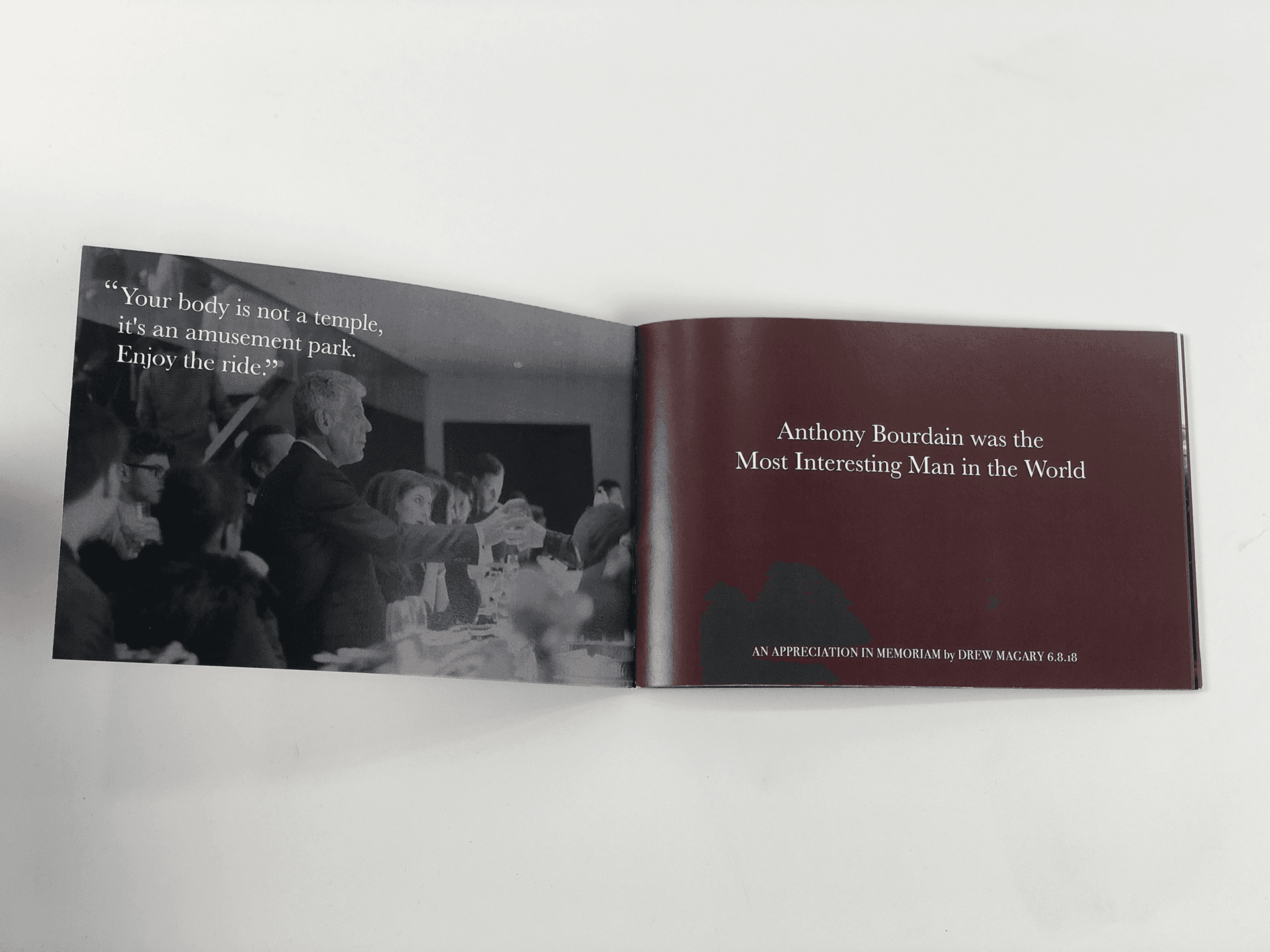



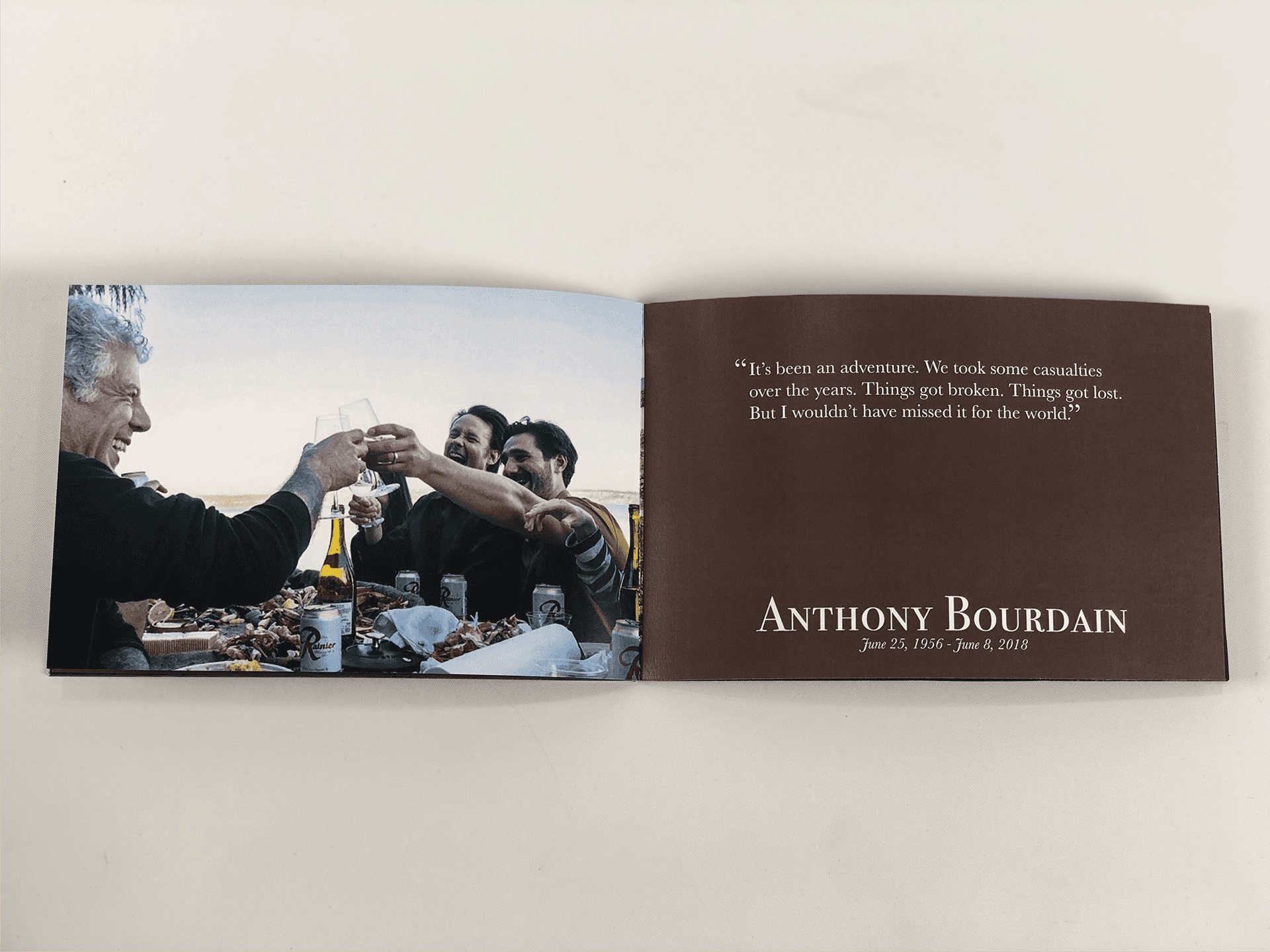

Also included are three recipes at the back of the booklet for readers to take home and try. One recipe is for scrambled eggs. The second calls for olive oil. The third for balsamic vinegar.
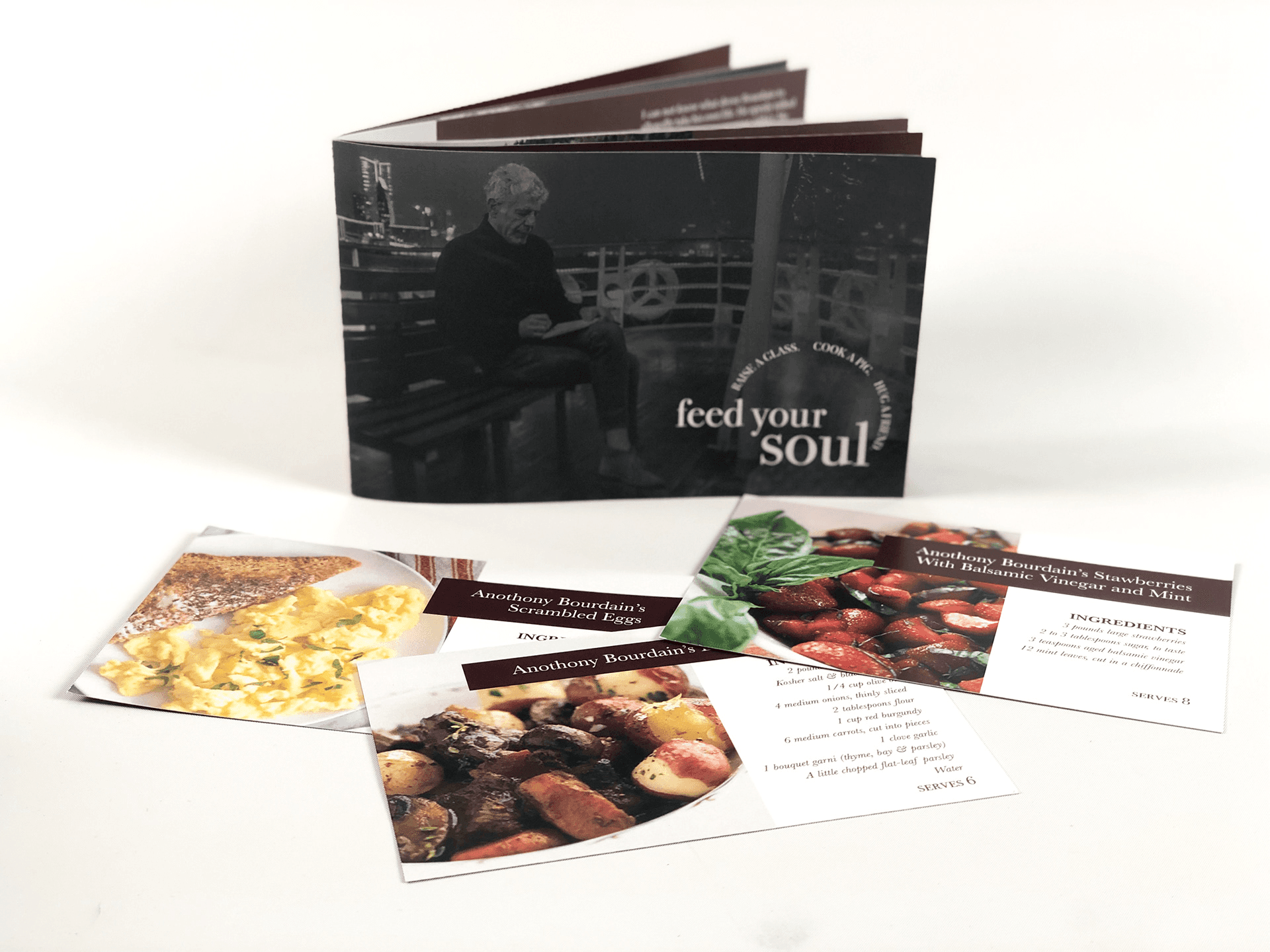

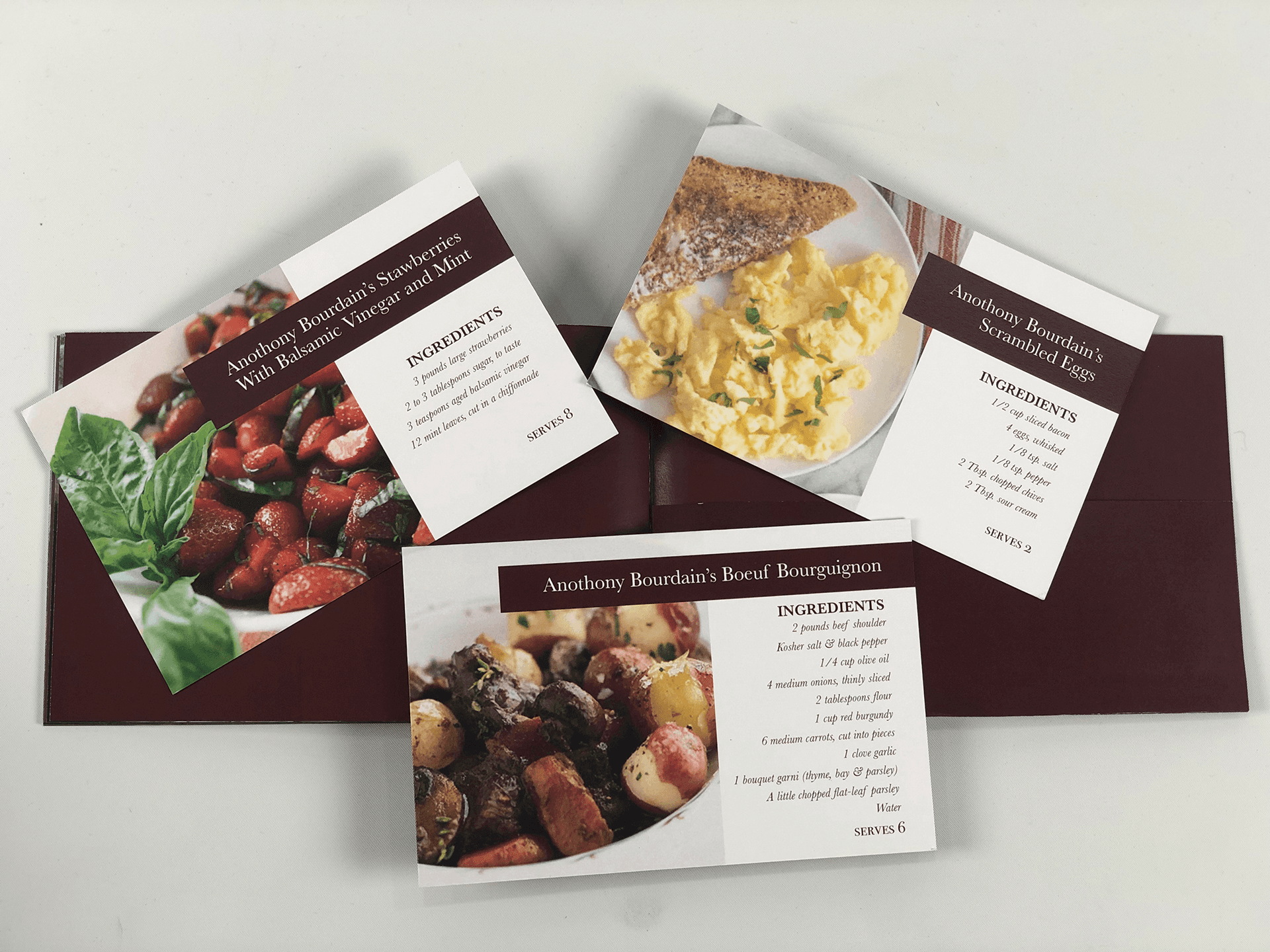



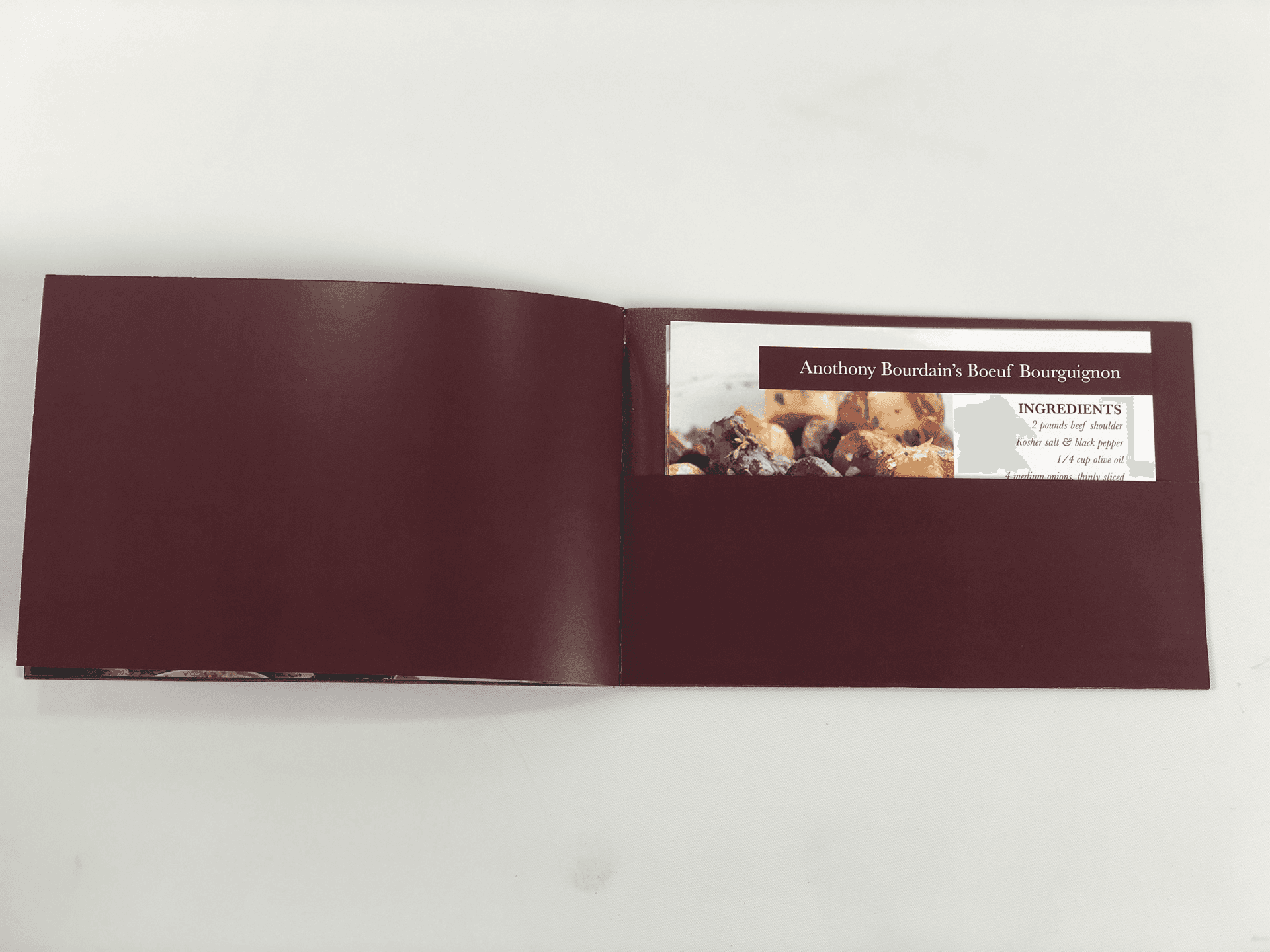

Souvenir Packaging
This package was designed in homage to the two most iconic things that Bourdain loved; food and travel. Repeating concepts from before, the square ends of the box are covered in a white on black map of Paris. The middle sides of the box are covered in a black on white map of New York City. On the bottom of the box, there is a line between red and white like the lines that form between olive oil and vinegar when poured together. The text reads "olive oil and balsamic vinegar are a timeless kitchen staple. Though typically paired, their chemical makeup repels one another yet come together to make a famous duo. One is thick and one is thin. When poured together, much like Anthony Bourdain, there is a fine line between the mix of light and dark." The top of the box repeats the visual motif of the map behind a quote from Anthony Bourdain.
Souvenir Packaging
This package was designed in homage to the two most iconic things that Bourdain loved; food and travel. Repeating concepts from before, the square ends of the box are covered in a white on black map of Paris. The middle sides of the box are covered in a black on white map of New York City. On the bottom of the box, there is a line between red and white like the lines that form between olive oil and vinegar when poured together. The text reads "olive oil and balsamic vinegar are a timeless kitchen staple. Though typically paired, their chemical makeup repels one another yet come together to make a famous duo. One is thick and one is thin. When poured together, much like Anthony Bourdain, there is a fine line between the mix of light and dark." The top of the box repeats the visual motif of the map behind a quote from Anthony Bourdain.
Souvenir Packaging
This package was designed in homage to the two most iconic things that Bourdain loved; food and travel. Repeating concepts from before, the square ends of the box are covered in a white on black map of Paris. The middle sides of the box are covered in a black on white map of New York City. On the bottom of the box, there is a line between red and white like the lines that form between olive oil and vinegar when poured together. The text reads "olive oil and balsamic vinegar are a timeless kitchen staple. Though typically paired, their chemical makeup repels one another yet come together to make a famous duo. One is thick and one is thin. When poured together, much like Anthony Bourdain, there is a fine line between the mix of light and dark." The top of the box repeats the visual motif of the map behind a quote from Anthony Bourdain.
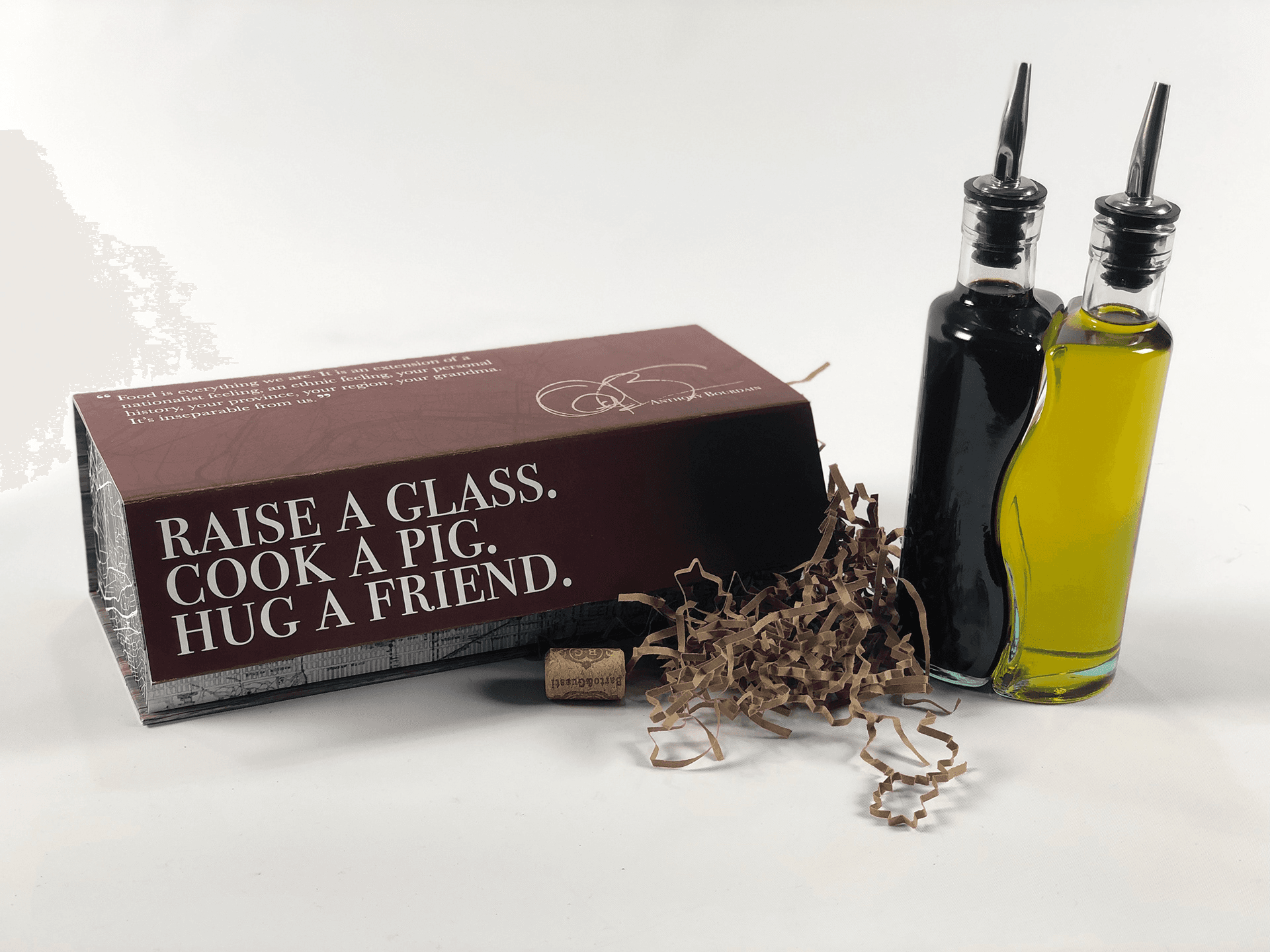

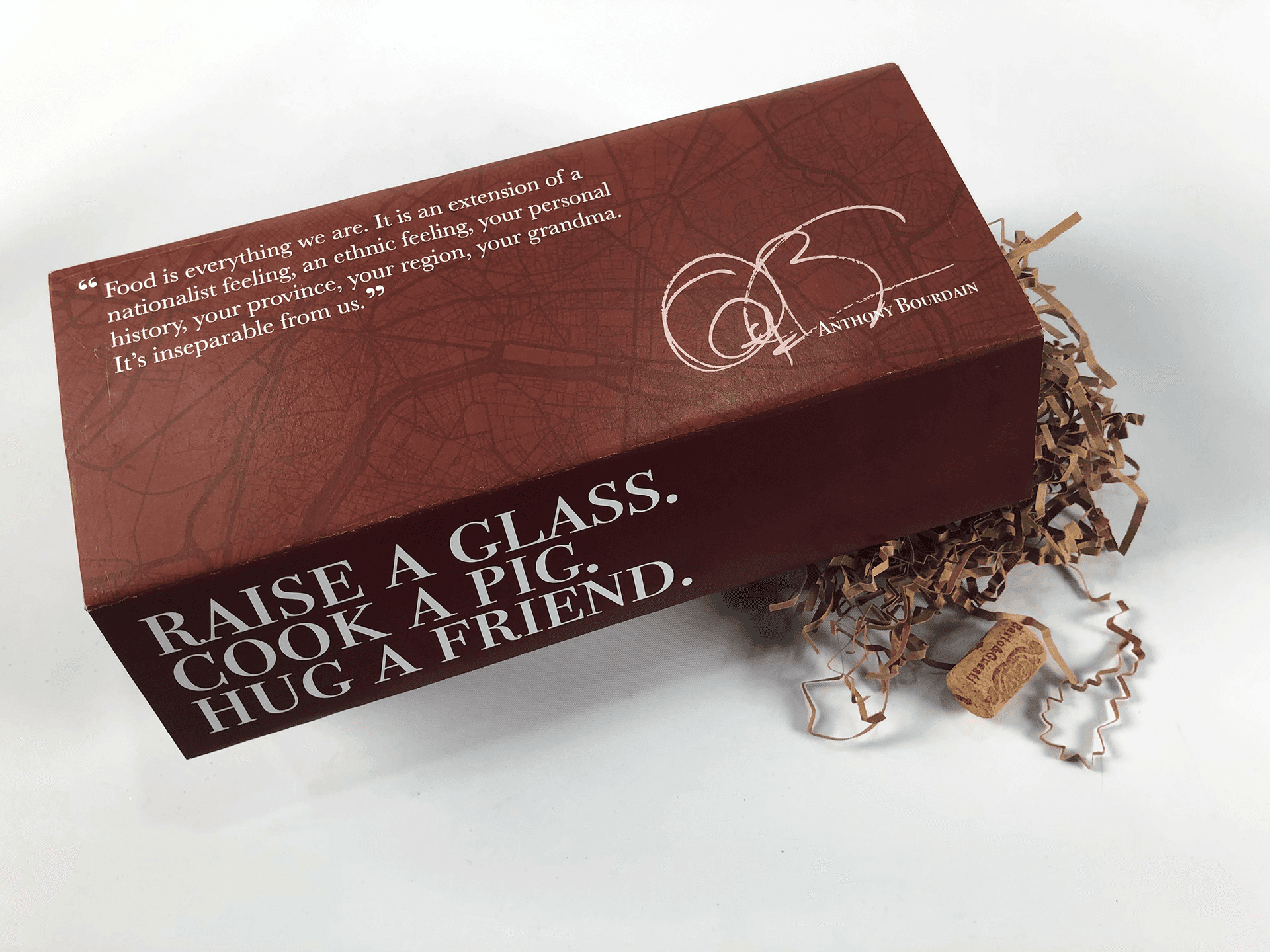

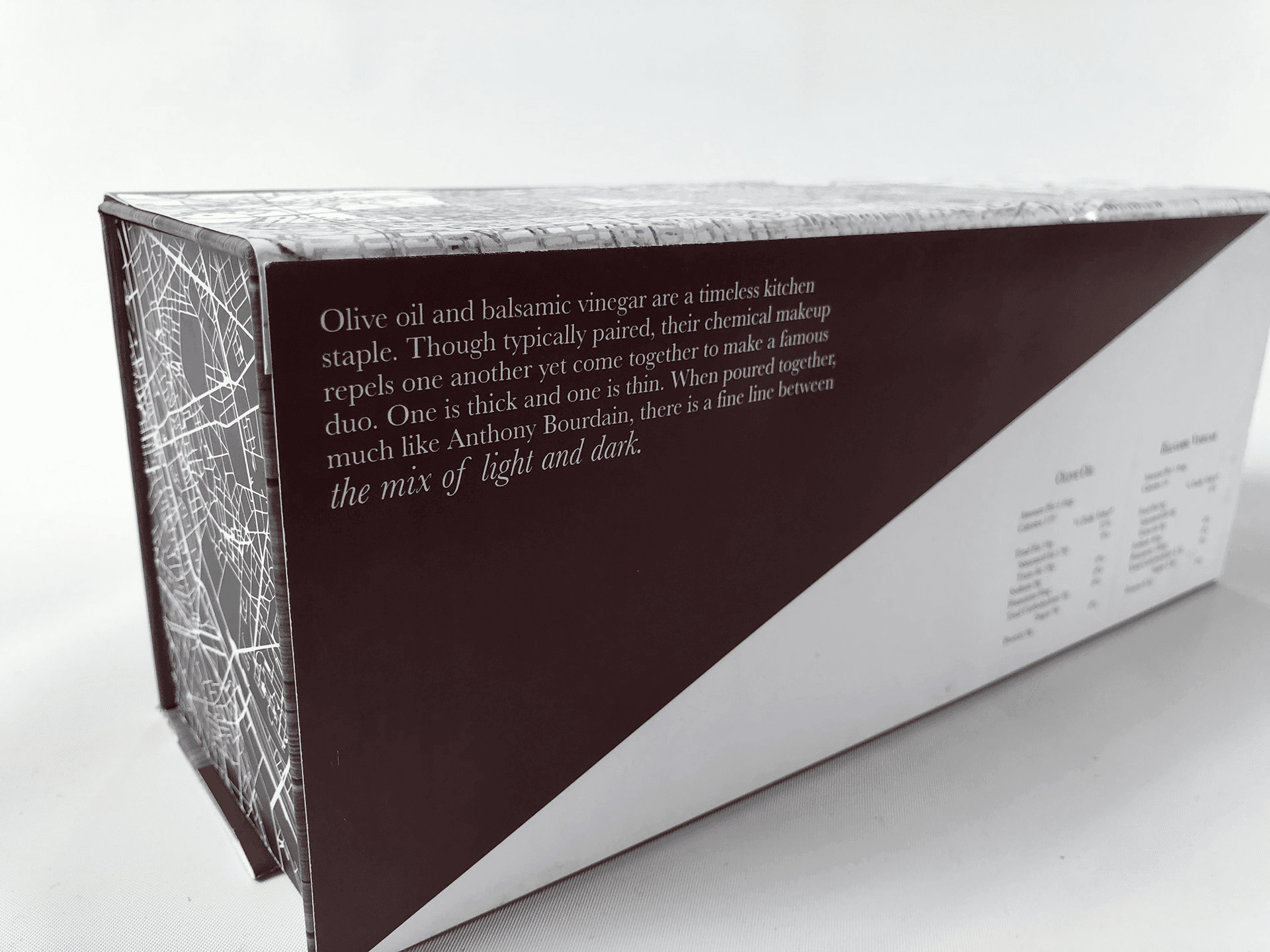





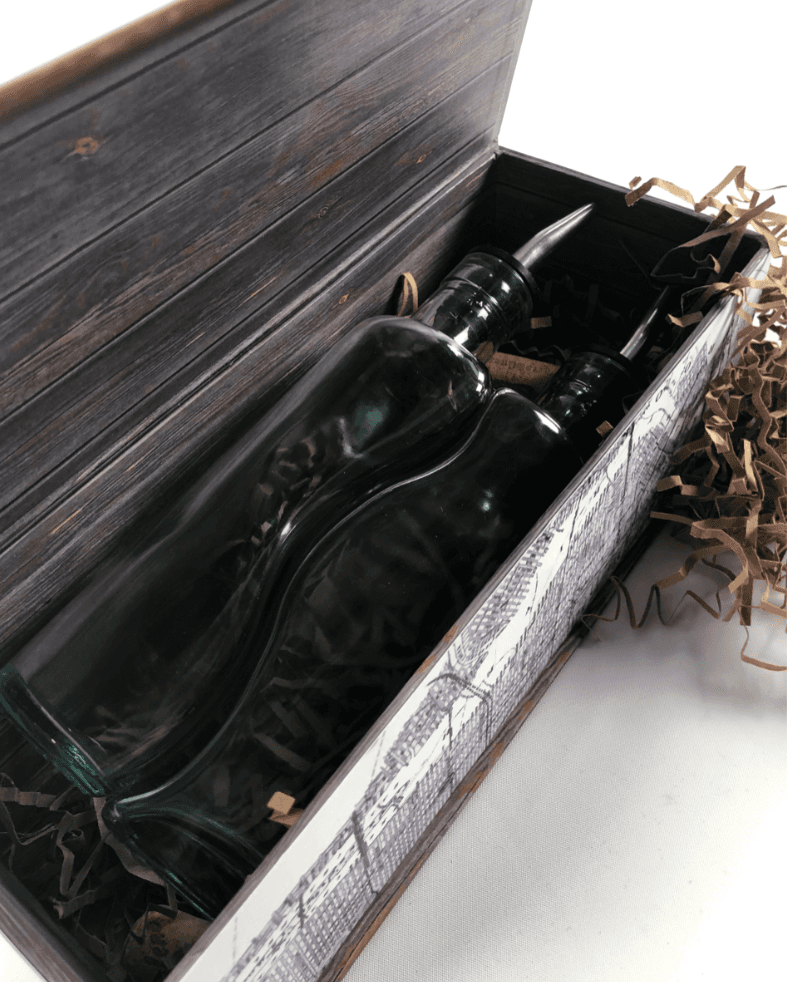

Debrief
Debrief
Though a conceptual project, Feed Your Soul remains one of my most personally meaningful works. Designing for someone as layered and beloved as Anthony Bourdain required empathy, restraint, and authenticity. This project taught me how to design not just for visual impact, but for emotional resonance. I hope this exhibit would not only reflect Bourdain’s life, but inspire others to live their own more fully—through food, conversation, and compassion.
